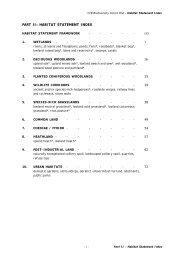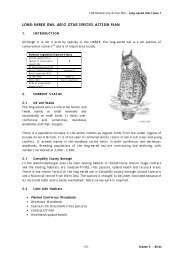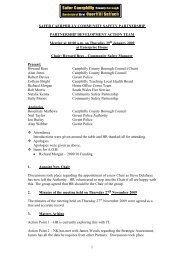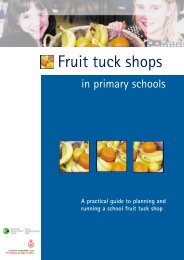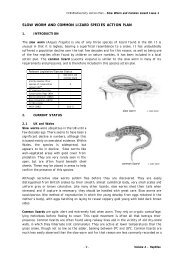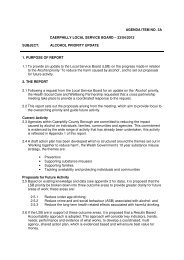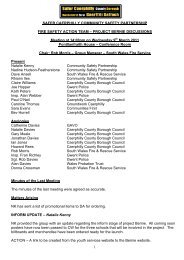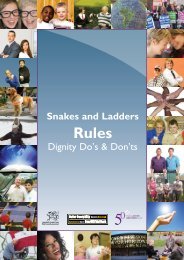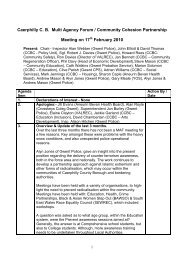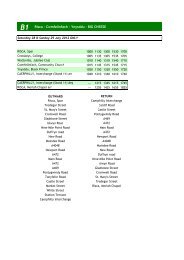BARN OWL TYTO ALBA SPECIES ACTION PLAN
BARN OWL TYTO ALBA SPECIES ACTION PLAN
BARN OWL TYTO ALBA SPECIES ACTION PLAN
- No tags were found...
You also want an ePaper? Increase the reach of your titles
YUMPU automatically turns print PDFs into web optimized ePapers that Google loves.
CCB Biodiversity Action Plan – Barn Owl Issue 1<strong>BARN</strong> <strong>OWL</strong> <strong>TYTO</strong> <strong>ALBA</strong> <strong>SPECIES</strong> <strong>ACTION</strong> <strong>PLAN</strong>1. INTRODUCTIONThe barn owl is not afforded priority status in the UKBAP, but it is a species of national andinternational conservation concern and is considered important locally. The presence of barnowls is a good indicator of the health of biodiversity in lowland areas; the range of habitatsrequired for owls are vital for a wide variety of other wildlife.Relevant Legislation/Species Statuspriority species (P) or speciesof conservation concern (S)SEC Birds Directive 1979 -Berne Convention 1982App. IIBonn Convention 1979 -CITES 1975Annex AWCA 1981Birds of ConservationConcern List 30Part I Section 1;Sch. 1, 3, 9Amber2. CURRENT STATUS2.1 UK and WalesThe barn owl is traditionally associated withsmall-scale mixed farming, with nest sites inhay barns or mature hedgerow trees. It is anocturnal predator, hunting over roughgrassland, woodland edges and hedgerows.© CCBC 2002In Wales, barn owls favour damp vole-rich grasslands and unimproved meadows, but are stillfound in a wide variety of farmland habitats. During the 19 th century much of Wales comprisedideal habitat for this species, but the clearance of 35–50% of woodland since 1933, and the lossof around 25% of Welsh hedgerow between 1984 and 1990, has had an adverse effect on thepopulation. The species has experienced an estimated 20–50% decline in its population over thelast 20 years. The last nationwide survey (1968-1972) estimated a UK population of 4500–9000pairs and with around 462 pairs in Wales in 1985 (reduced from 1436 pairs in 1932) 33 . Thisdecline has slowed since the 1990s, and populations are now relatively steady.2.2 Caerphilly County BoroughThe barn owl nests and breeds in tree cavities, old/derelict farm buildings and barns, pit shaftsand quarry faces. It feeds mainly on small mammals such as voles, shrews and mice. They huntmainly at night over areas of rough grassland, field margins, hedgerows, derelict land, parkland,roadside verges, water courses, woodland edge habitats and newly planted woodlands. Breedingbarn owls have been recorded at scattered locations throughout the county borough, butfurther survey work is required to confirm the status of this species in the area.2.3 Links with Habitats• Deciduous Woodlands (woodland edge habitats)• Wildlife Corridors (open fields and hedgerows)• Common Land- 1 - Volume 2 - Birds
CCB Biodiversity Action Plan – Barn Owl Issue 1• Post-Industrial Land• Urban Habitats (derelict industrial areas)• Rough grassland3. CURRENT FACTORS AFFECTING THE <strong>SPECIES</strong>• Loss of hunting habitats through agricultural intensification, e.g. pasture management,development and afforestation, and the subsequent decline in prey species populations havehad their impact on the barn owl population.• Lack of long grass in field margins as shelter for small mammals has led to increased huntingon roadside verges, leading to an increase in road deaths.• A lack of mature trees, in hedgerows and open farmland, for nesting and roosting sites.• Over-use of toxic pesticides and rodenticides which get passed up through the food chainand poison the barn owl.• Effects of climate: hard winters have led to many owls dying through starvation. This is dueto the reduction in food supply - small field mammal populations fluctuate seasonally withthe changing climate, and in very cold winters food can become scarce, for example on snowcovered farmland.• Increased road development and urbanisation: there is often localised barn owl decline inareas of expanding towns.• Demolition or conversion of old agricultural buildings and the design of modern buildingsmakes them unsuitable as nesting sites; e.g. with no suitable ledges or entrances.• Disturbance to nesting and roosting sites (often unintentionally) by human activities.4. CURRENT <strong>ACTION</strong>4.1 It is illegal to release a barn owl into the wild without a licence. Incorrectly releasedbirds are often unable to survive. Under official release schemes, however, where owlshave been released under controlled conditions, barn owl survival is much greater,enhancing the wild population.4.2 The Barn Owl Trust is a national organisation aiming to conserve the species and itsenvironment. It also provides a free information and advice service.4.3 CCBC Planning Division have placed conditions on some barn conversions to include barnowl surveys, and if present, barn owl mitigation, in the form of boxes and workingrestriction. In addition, planning applicants are encouraged to consider barn owlmitigation regardless of current useage.4.4 Preservation of rough grassland sites (species-rich grasslands designated as SSSI orSINC) 8 .4.5 Provision of nest boxes in some areas, for example a joint scheme between theEnvironment Agency and The Hawk and Owl Trust.- 2 - Volume 2 - Birds
CCB Biodiversity Action Plan – Barn Owl Issue 1ActionKey PartnersYear to be complete or in place by:Lead Partners 2003 4 5 6 7 8 9 10 116.2 Site Safeguard and Management (continued)6.2.2 Seek to restore/re-create suitablefeeding habitats/linear features, toprovide a network of foraging/breedingsites, and encourage the installation ofnest boxes where appropriate.CCBC CCW ü ü6.2.3 Encourage the use of nest boxesboth in new buildings and in therenovation of existing structures.6.2.4 Seek to include the needs of barnowls in the management of wildlife sites(SINCs).6.2.5 Ensure the reclamation of formercolliery sites incorporates barn owlrequirements, for example using nestboxes and raptor perches in suitablelocations where appropriate.6.3 Species Management and Protection6.3.1 Seek to create new nesting sites byproviding nest boxes and safeguardingmature trees in suitable areas.6.3.2 Investigate the provisioning of nestboxes in council-owned buildings in thecounty borough.6.3.3 Seek to encourage barn owl nestbox sponsorship in the county borough.6.3.4 Seek to set up 'Barn Owl Projects'in communities or in the county boroughas a whole6.3.5 Educate land managers of the needto reduce the use of rodenticides andpesticides through carefully targeteduse, or alternative methods of pestcontrol.6.3.6 Continue to implement wildlifelegislation.6.4 Advisory6.4.1 Ensure the provision of advice torelevant organisations and land-managerson the conservation of barn owls andsympathetic management of habitats.6.4.2 Disseminate information regardingringing of owlets and the monitoring ofnest sites to interested organisations andrelevant individuals.6.5 Future Research and Monitoring6.5.1 Undertake a county wide survey todetermine the current status of the barnowl.CCBCCCBCCCW RSPBGWT GLWTGWTGLWT RSPBüü ü ü ü ü ü ü üüü üWDA CCBC FC ü ü ü ü ü ü ü ü üCCBCBTO GOSGBC RSPBEAü ü üCCBC ü üCBP RSPB üCBPNAWADGwentPoliceCBPcommunitygroupsFUW NFUCCBC CCWüüüü ü ü ü ü ü ü ü- ü ü ü ü ü ü ü ü üADASRSPBüü ü ü ü ü ü ü üW<strong>OWL</strong>S - ü ü ü ü ü ü ü ü üGBCGOSBTO RSPBËËSurvey year to be determined.- 4 - Volume 2 - Birds



